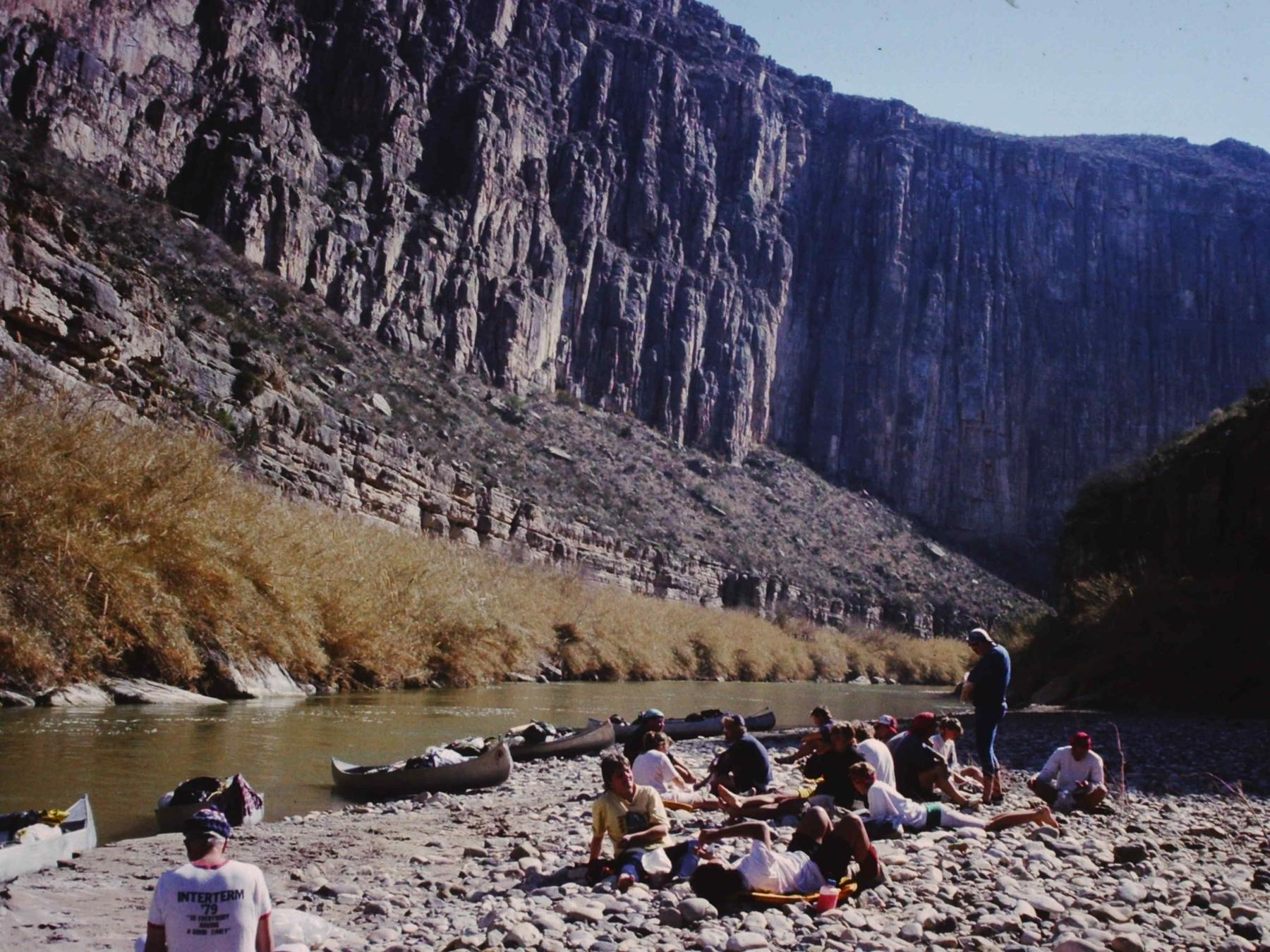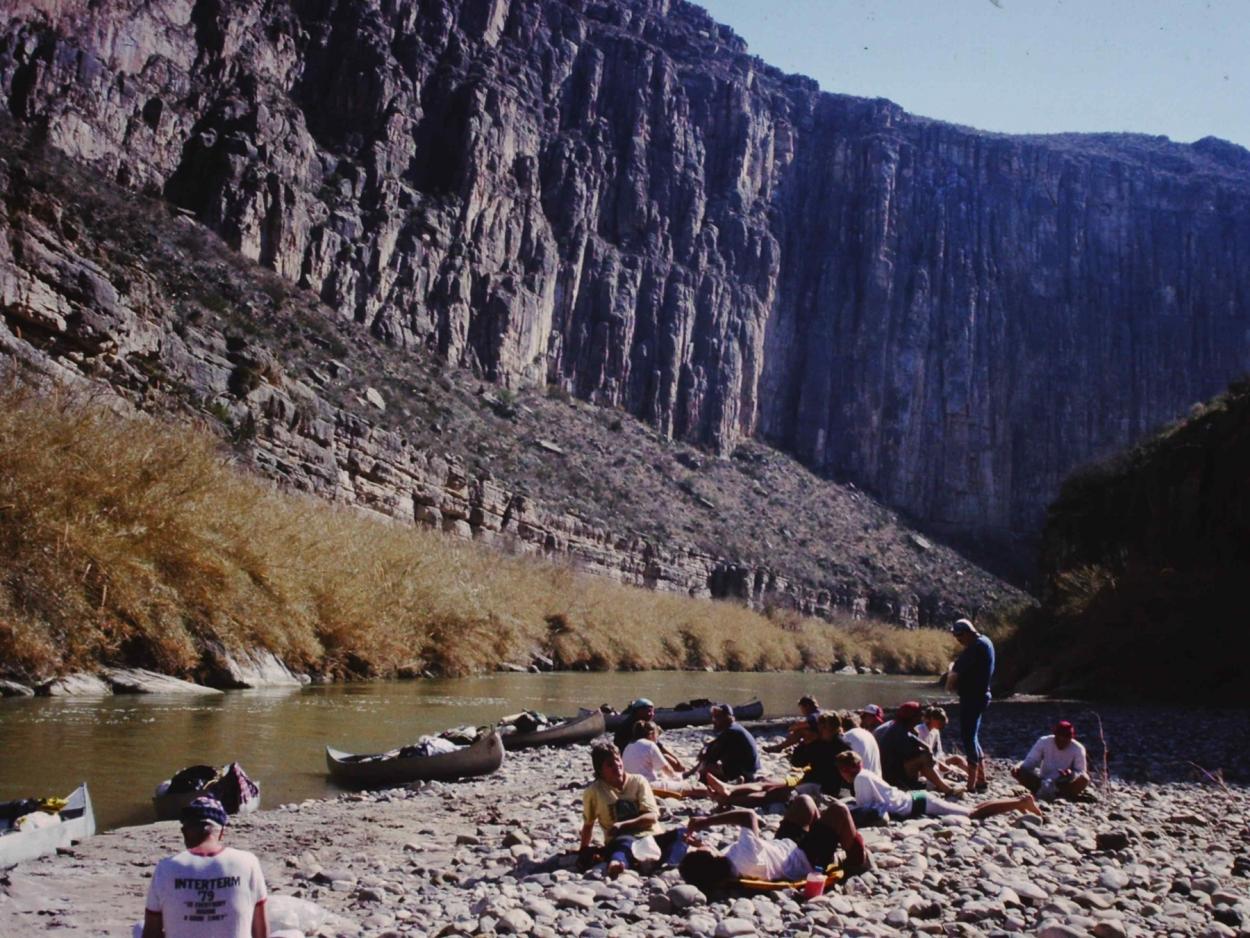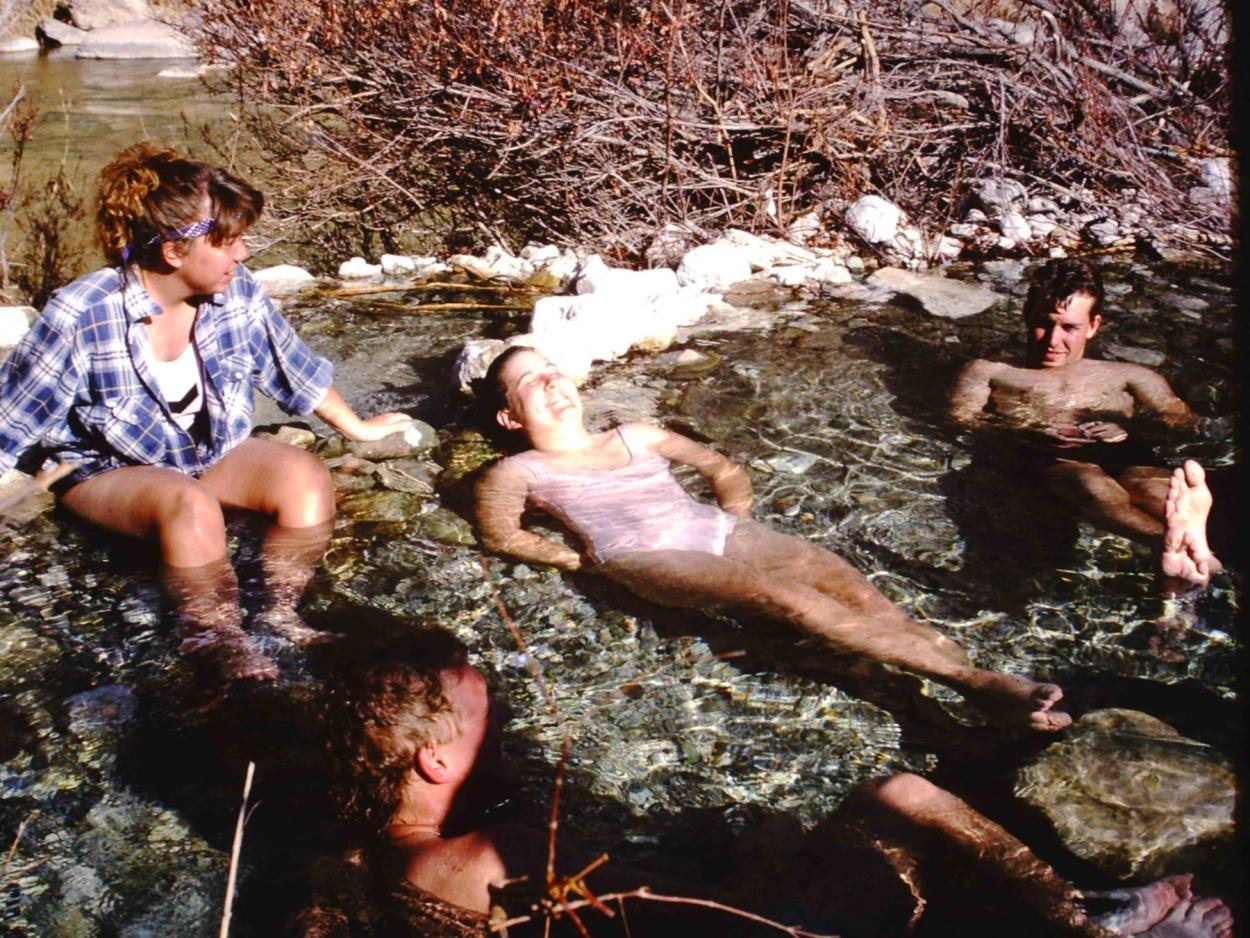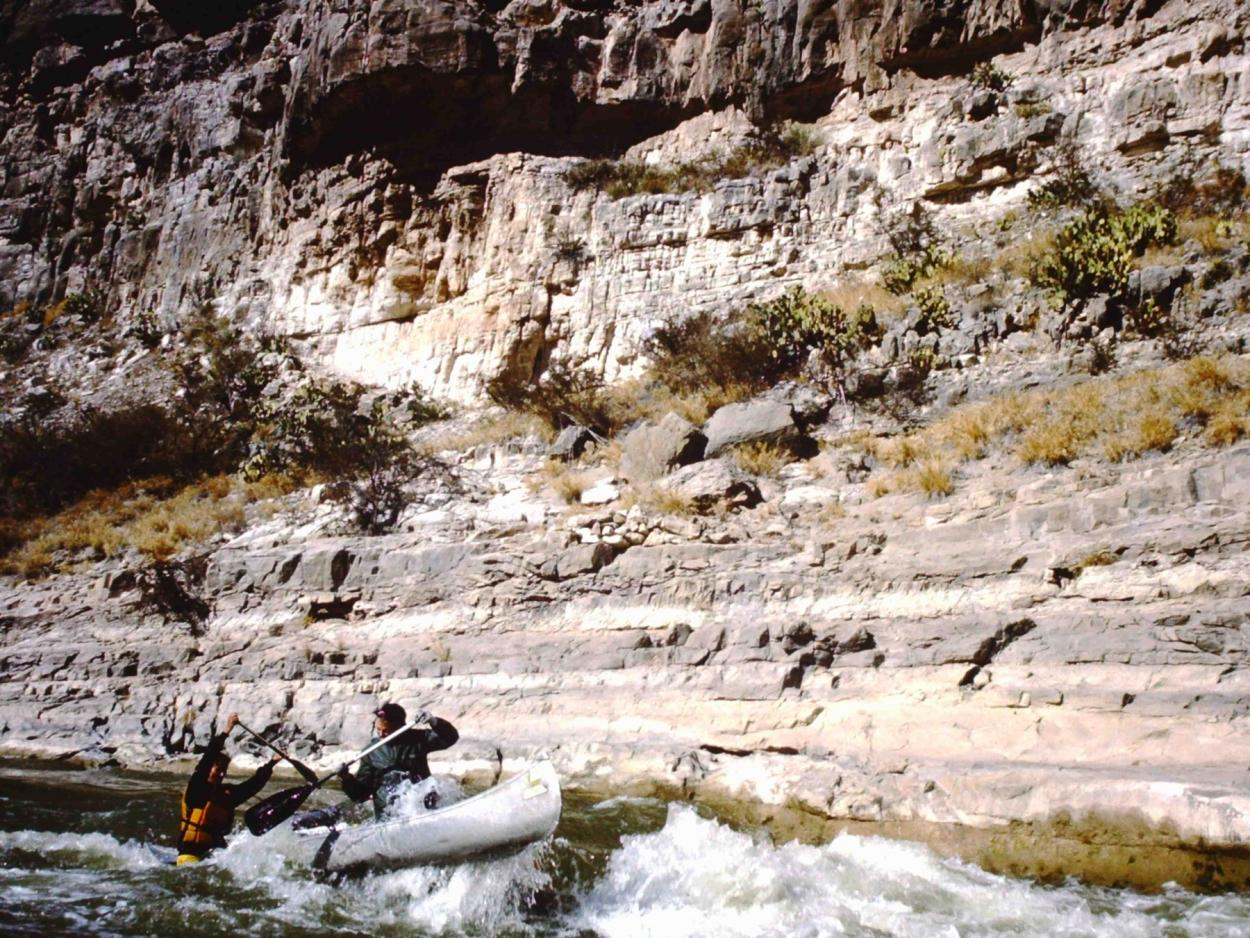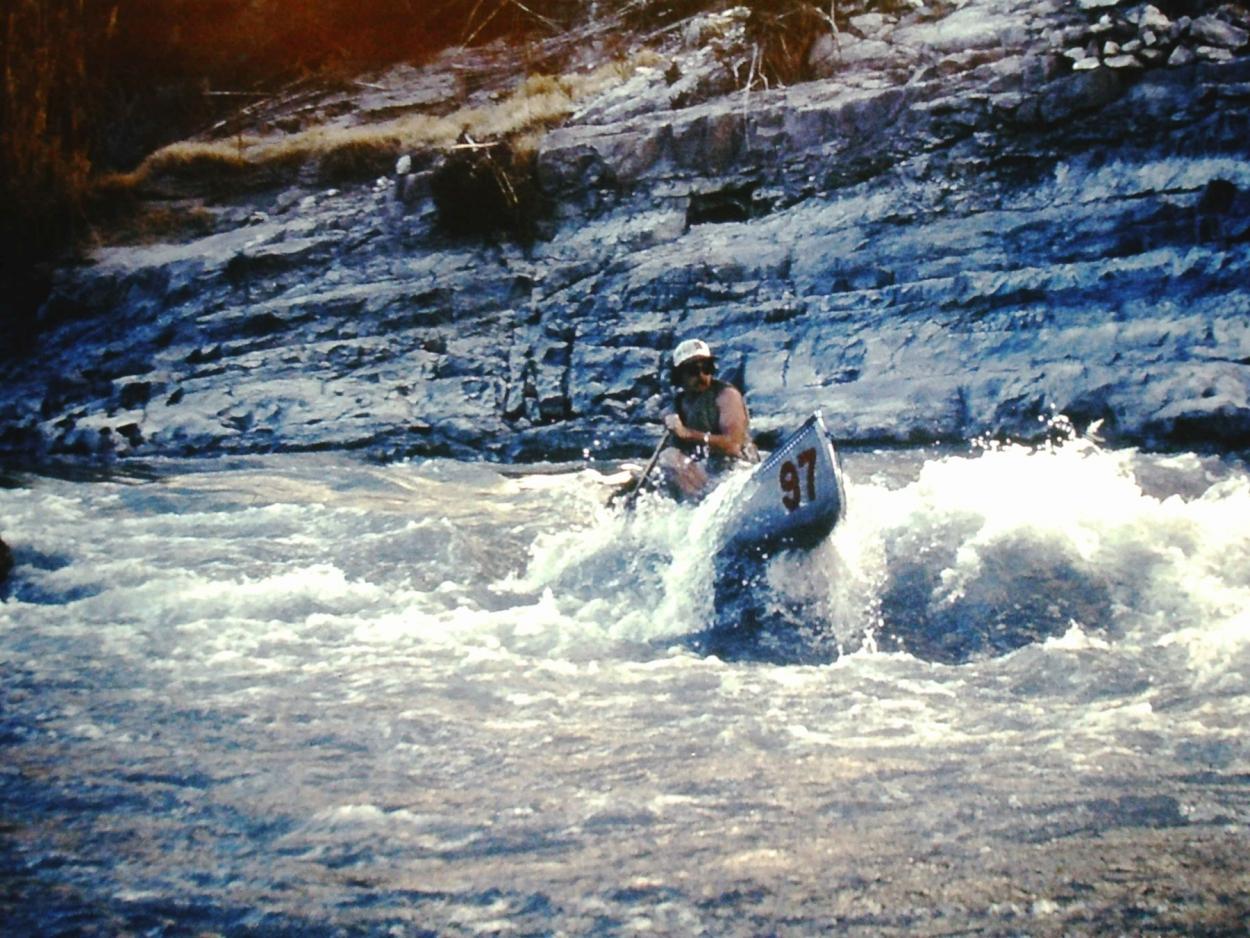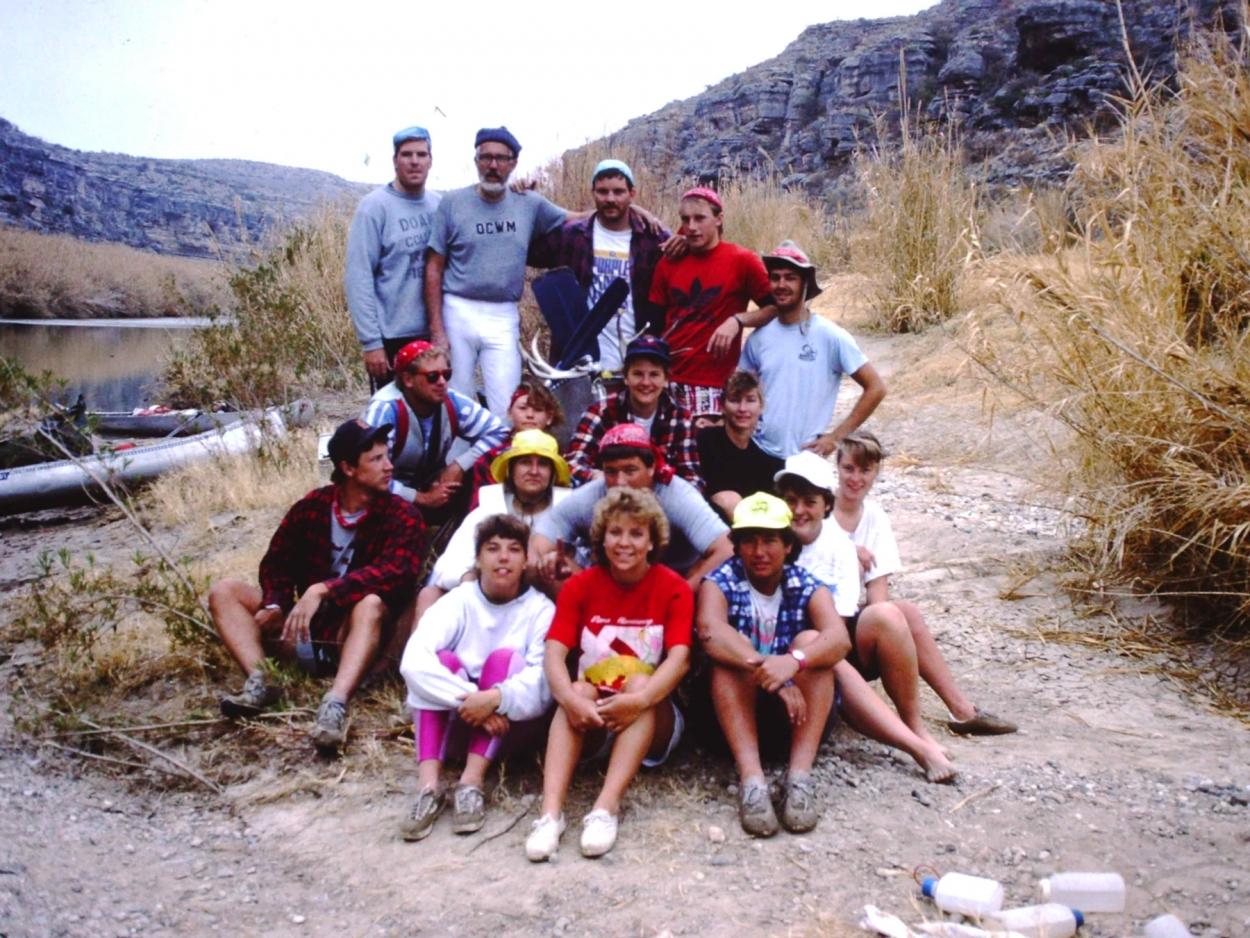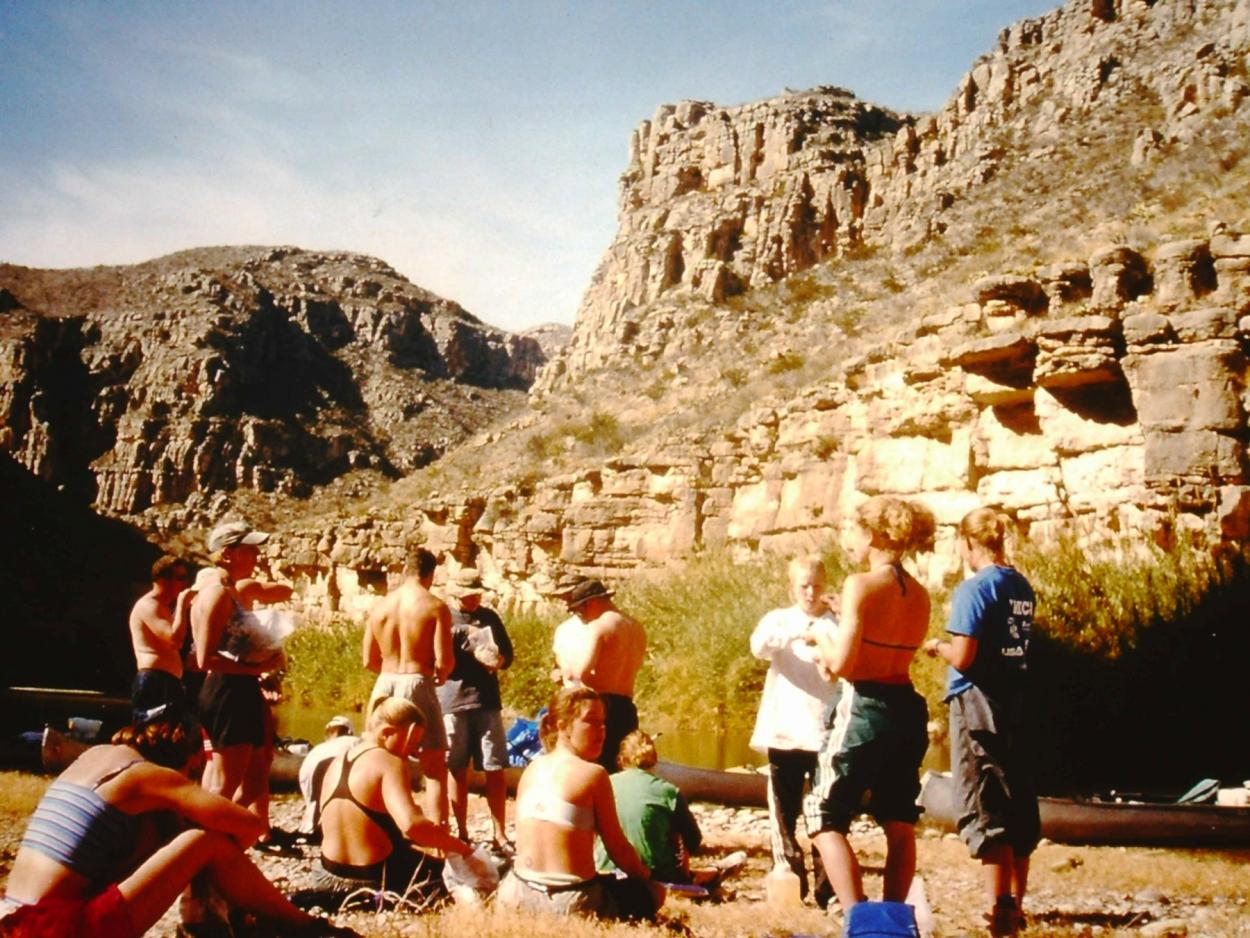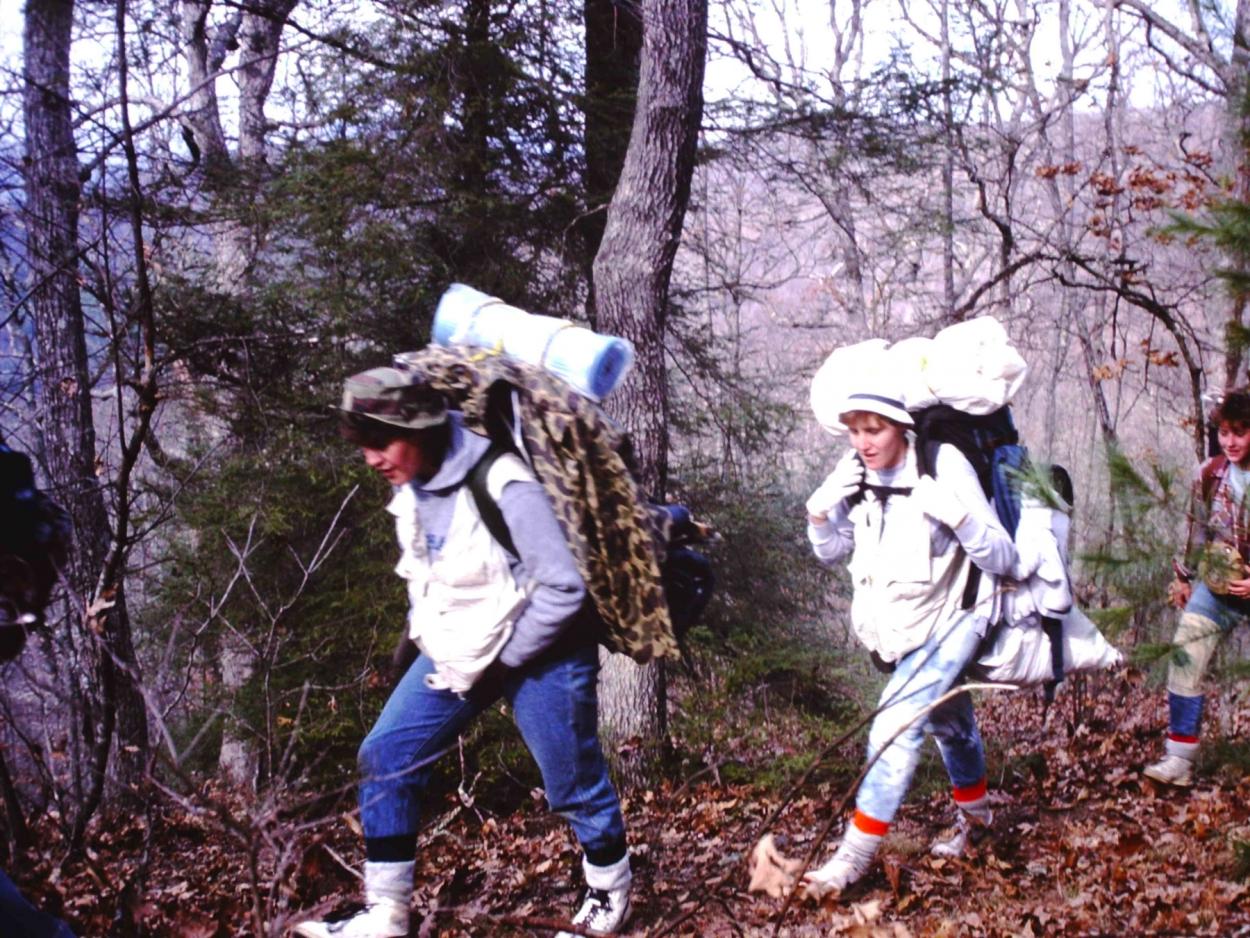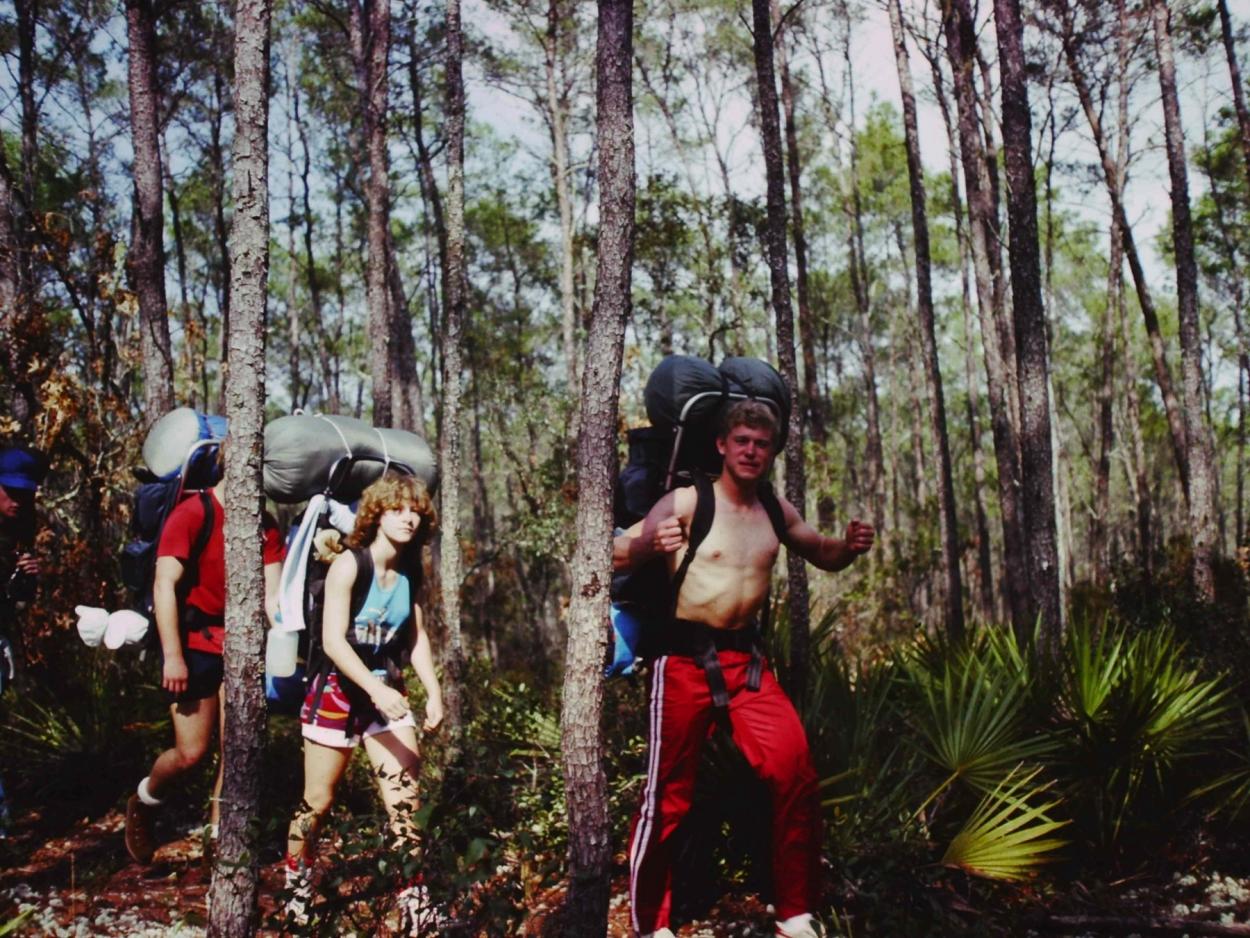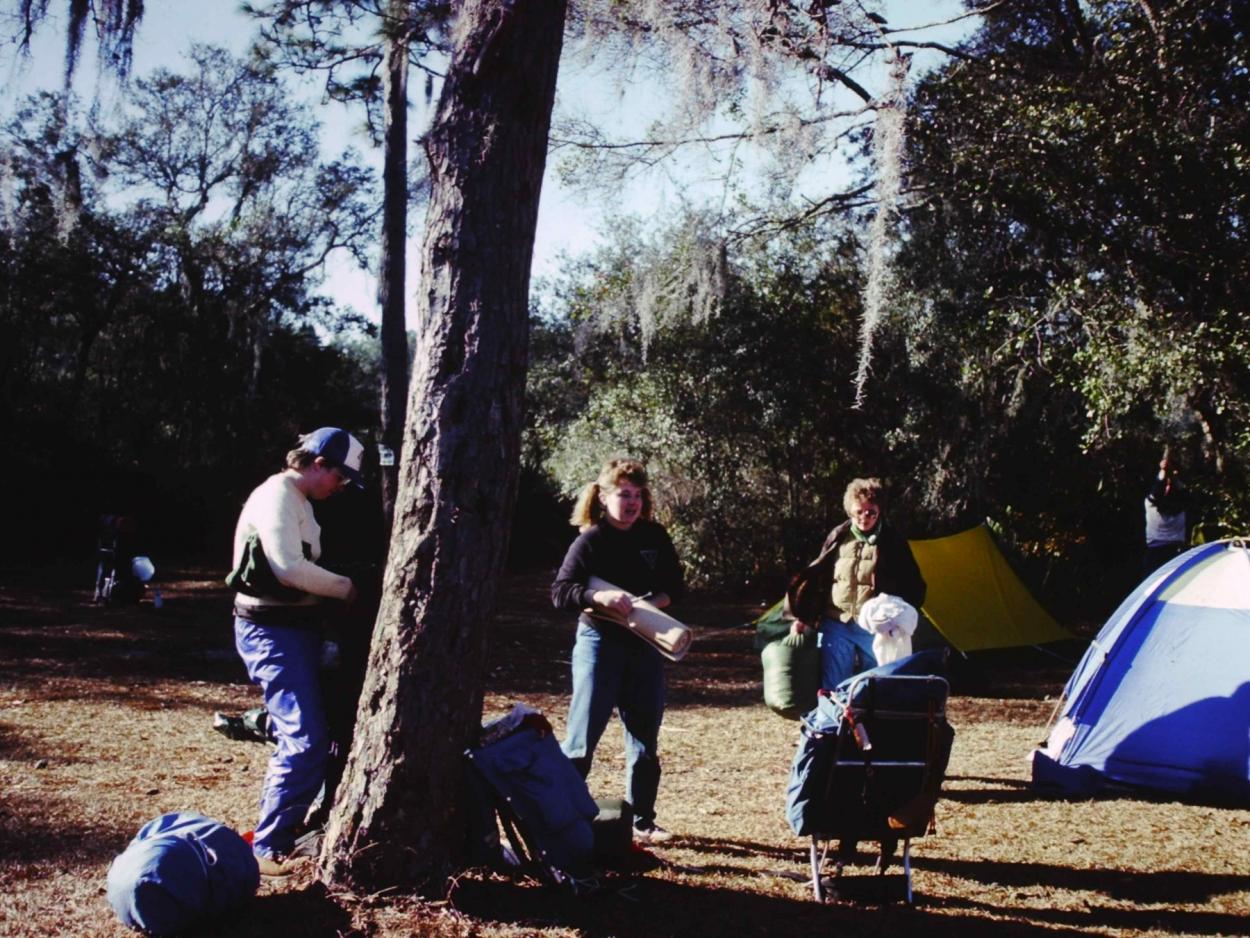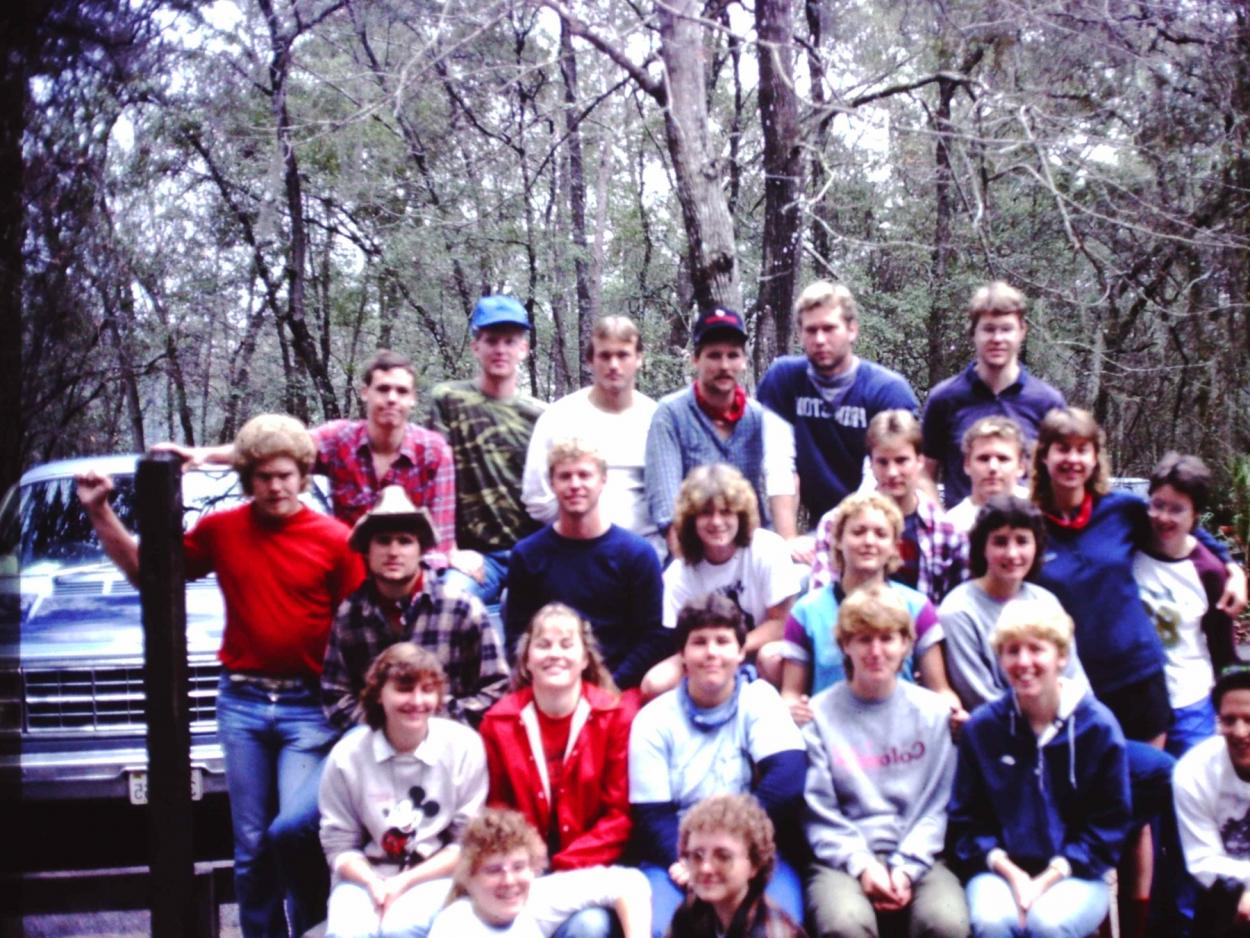For nearly 30 years, Doc Dudley '56 and Ned McPartland's adventures inspired generations of Doane alumni.
Article by Liz McCue
Sure, there were challenges. Like the time when a tent and contents were stolen from camp along the Rio Grande. Like the nights before cell phones when all that could be done with a broken-down van was to hitchhike to the next town and hope someone was awake. Like the discomfort of putting up with damp socks on a long hike.
But there was also triumph. Camaraderie. New friends and lifelong partners. Personal growth and probably some spiritual growth, too — faith was at the heart of a lot of the adventures led by Dr. Dick “Doc” Dudley and Dr. Ned McPartland from 1972 through the early 2000s. Faith in yourself, your fellow students, Doc and Ned’s leadership, and in the kindness of strangers met throughout the course of a three-week interterm trip.
Doc began the trips by himself in 1972. At that time, he taught European history, and his students had complained to him about the traditional interterm, an hours-long lecture about one subject taught for three weeks in January. He proposed a trip in place of a lecture and received the blessing of the dean.
It was the repeat of a trip he and his wife, Lillian “Bunny” Albrecht Dudley '55, had taken as a summer vacation, traveling by train through northern Canada. But Canada in January is a little different.
“Nothing about that was smart,” he said, between the four hours of daylight and the extreme cold of the Canadian winter.
To the students, though, the trip was a delight. And a tradition was started.
After leading four trips on his own, Doc was approached by Ned, a professor of political science. They got to talking.
“When I met Ned, that was the best,” Doc said. Working together brought out the best of their individual personalities and skills. If Doc was good at one aspect of the trip, Ned was good at the other. Ned typically led the students who wanted to go faster, whether it was canoeing, hiking, or cycling, and often found and started making camp.
“I’d be there two hours later with my kids,” Doc said of the students who couldn’t go as quickly. But that way, no one was ever left behind or excluded.
The duo primarily did three types of adventure trips: canoeing, hiking and cycling. There were many trips paddling the waters of the Rio Grande. The Great Smoky Mountains proved to still be chilly for January hiking and camping, but the southern reaches of the Appalachian range in Georgia were just right, and multiple trips were taken to mountains and forests there and in Florida.
Four cycling trips were made along the coasts of Baja California, in Mexico. There was one backpacking trip through Copper Canyon, in the state of Chihuahua, after a train ride through the mountains from Los Mochis. And one canoeing trip along the Rio Valles near Ciudad Valles.
There was the one with the sailboats, too, but “it was just average,” Doc said. It was one of the coldest winters on record in Florida, and he and Ned had just learned to sail themselves the summer before. They rallied the trip by turning it into a gourmet campfire cooking class and by cutting time in Florida short to explore the cuisine and culture of New Orleans.
Almost every year, there was somebody who would cause problems and make a little trouble. In a group of 18 college students, that’s hardly unexpected. But in the middle of a river, a forest, a mountain, far from any town and any help, acting out could cause real harm.
“I’d talk to a student only once. ‘This only happens once,’ I’d say, ‘or you’re gone,’” Doc said, with the implication that the student would be on their own to get back home. In over 20 years, that threat never had to be realized; some trip alumni even write Doc still about how that moment led them to change.
“I know they learned from this experience,” Doc said.
Outside of the technical skills learned on the trips — how to canoe whitewater rapids, how to pack for long trips, how to set up camps — lessons were learned in other ways and varied from student to student. A big one was learning that life can hand you a lot of lemons. But another lesson was in how you can use those, and still make something great.
Case in point, no matter how many plans were made, or how many times Doc and Ned had led students on the same route, their interterm trips “were packed from start to finish with error,” Doc said.
“Part of the idea was, as we got into it, that it sounds exotic and like a vacation but we also wanted people to learn to cooperate and work together,” Ned said. “And that was true of all these trips. We interviewed people and they had to have permission before they enrolled.”
For many of the couples who went on trips together, or who had their meet-cute on the trips, it was like a “trial by fire,” Doc said — and more than a half-dozen couples later married. The more challenging situations, and even the mundane tasks, could put relationships and friendships to the test. These situations also brought plenty of people together, creating long-lasting friendships among the students, Doc and Ned.
Because of his role as chair of the education department, Doc went on fewer trips as the years went by, and retired in the late ‘90s. Ned continued to lead several trips on his own until 2003 with smaller groups, hiking in Georgia and Florida, a few more canoe trips in the Ozarks and on rivers in Wisconsin, Minnesota and Iowa.
Canoeing the Rio Grande
Each trip to the Rio Grande started with the 18 or so students learning to tandem paddle in the canoes, set up camp, and other skills needed for the long haul down the Rio, usually on a pond in Texas Hill Country or the San Marcos River, which was a little gentler.
“People would make their mistakes, but they wouldn’t have all their gear in the boats,” Ned said. “ By about the end of the week, most people would have the hang of it.”
Students cycled through different duties to set up and take down camp — gathering wood for fires to make dinner and breakfast, purifying water for drinking and cooking, setting up tents, etc. It took a little time for everyone to learn the ropes, including Doc and Ned. For example, they initially used large coolers in the canoes to carry food, which took up a lot of room.
“We did get better at it,” Ned said. “The first time, it was pretty funny, we ate like kings the first few days. Then we ran out of food and it was macaroni and cheese, or something like that, the rest of the trip.”
He said during that first trip, students were so hungry they caught fish from the river and set traps to catch javelinas, but “fortunately, they didn’t catch one.”
After that, they typically bought a lot of dried food and canned meat, some seasonings and sauces, that could be packed and cooked with water. It was waterproofed in large plastic leaf bags.
“The equipment then wasn’t as good as it is now,” Ned said.
They used aluminum canoes that could stand up to a beating from the rocks and rapids, but there were always accidents. If a canoe tipped and got grabbed by the current, it was much heavier and harder to rescue, with a couple over the years lost that way. Ned did plenty of paddling on his own and noticed canoeing outfitters putting styrofoam blocks in their canoes for extra floatation. It took up space, but after that, they were able to recover more canoes and prevent damage.
The trips first started putting in at Big Bend National Park but took too long. So Doc and Ned shortened the route to around 85 miles and changed their starting location to the La Linda International Bridge east of the national park.
The canoes and gear needed for the river trip would be unloaded on the U.S. side at La Linda, then the vehicles and canoe trailers would be driven to a private landing a few hours drive away to be ready when everyone got off of the river a week later. The majority of that time was spent getting over rough roads and through cattle gates. Ned ended up having to make a quick fix out of baling wire and 2-by-4’s once when a trailer was damaged going over the road.
Once they got on the river, for as much planning was done ahead of time, the shifting nature of the river meant playing it by ear.
“You hoped you found something around 3 o’clock,” to set up camp, Ned said. Once the shadows started falling, it would drop 15-20 degrees, and that’s when you wanted to be sure you could gather around the campfire or huddle in a sleeping bag. Those cold nights also sparked a lot of memories — singing around the campfire and listening to everyone’s experiences from the day.
Biking in Baja California
It sounds idyllic — riding a bike down a highway along the Pacific coast, camping on the beach, exploring rural Mexico. And for the first couple of trips, it was.
“Baja was not very populated at that time,” Ned said — so it was just them, the road, the sky and the sea. And sometimes mountains, if they crossed them to ride along the gulf.
Like the canoeing trips, students would train for about a week before the big trip in a park on the southern border of California. They would cross the border at Tecate, leaving the vans and trailers in the U.S. and taking only what they could carry by bike.
“I ended up being the bike mechanic,” Ned said. There were a couple of times that someone had to finish the trip with a crooked wheel or brakes that didn’t quite work.
“Once, on the last night of our trip, one of the bikes broke down and we couldn’t fix it,” Doc said. “I ended up hitchhiking my way out of Mexico to get our van and trailer at the border. Probably walked 2-3 miles before I got a ride and it took me 8-9 hours total before I came back to pick everyone up.”
As the years went on, the highway got busier and more dangerous. There was no shoulder to ride on, and close calls with traffic were getting too close. That was where they drew the line. ”There was a real risk of someone getting hit,” Doc said.
“I mean, I just worried all the time,” Ned said. “You can fish people out of the water; backpacking, you can pick them up off the trail. But on their bike, if they wobble out in front of a semi, there’s not much I can do. Fortunately, that didn’t happen.”
There were some really good moments, though. Once, there was a really bad storm, too strong for them to do more than hunker in their tents. A local farmer came to get them.
“His wife had fixed food and he had a large barn that we could stay in until the storm passed,” Doc said. “We spent at least two nights in that barn.”
Canoeing the Rio Valles
Not every trip was repeated, although in the case of canoeing the Rio Valles in San Luis Potosi, it had more to do with the effort taken to get into Mexico than any danger on the river. Crossing the border took almost a full day there and back.
It was difficult to plan for the trip, too. Neither Doc nor Ned had previously paddled the region, and maps weren’t great. There was so much growth along the riverbanks, it also wasn’t immediately clear that the river had many forks and branches that parted around islands. On this particular day of the trip, one of the students was sick, so Doc and daughter, Judy Dudley '81, stayed with the student while Ned and the others got on the river.
It took some time for them to realize they weren’t seeing the bridge where the two groups would meet at the end of the day. And it was starting to get dark.
“People were doing their washing at bridges,” Ned said. “We spoke to a woman to see if she knew how to get back to Ciudad Valles, and she said, ‘I’ve never been there.’”
It got pitch black as night fell, and the group on the river could hear rapids in the distance with no idea if they were easily paddled, or a waterfall. Finally, they reconnected with Doc and Judy, who were able to figure out with the help of a local doctor that the river branched and where they could meet up with everyone still on the river. It had been a long, long day.
But this is where that faith came back into play. The doctor they met ended up knowing a farmer, who had a sugarcane field close to the river with a large gazebo where they could camp.
“We ended up staying there most of the trip,” Ned said. “It turned out to be a really fun river, with small rapids and moss that covered the rocks so you just slid off them.”
“It turned out to be a really good trip.”
Interterm Testimonial: Mark Christiansen '81
Christensen attended the Rio Grande canoe trip in 1980 and Florida backpacking and sailing trip in 1981.
On those canoe trips, you would be on the river for 120 miles. You really had to be self-sufficient for however many days. Our trip, one of the canoes hit a rock, tipped and began taking on water. The water wrapped it around the rock with both ends.
I was toward the end of the line with Doc, kind of on the rescue crew. I was a larger guy, and another student and I jumped out and tried to pull it off of that rock. It wasn’t easy with the force and weight of the water — someone said “I think I even saw the rock move.”
Once we got the canoe off, we jumped on it to pound it out, and used duct tape and liquid aluminum. We distributed all of their supplies among the other canoes except for their life jackets and a bail bucket. That canoe leaked the entire rest of the way.
And Ned, he was just completely unflappable. At the end of it, he just said, “well, that was interesting.”
They were both just great people. They truly had the spirit of adventure and it was infectious. I can’t think of anyone who didn’t have a good time.
Interterm Testimonial: David Dudley '87
Dudley attended two trips to the Rio Grande and one trip to canoe the Rio Valles in Mexico after graduating from Doane.
On these trips, you were learning things that can’t be taught in a classroom. And all those experiences, they’re unique to the group. For example, because of Ned McPartland, I got to pitch my tent at the bottom of a Mexican dump. We didn’t know it was a dump — there was a terrible storm and it was already dark. We just needed a place large enough to hold all of us in our tents. But no one believes me when I say it, except the people who were there. That trip, it had taken us a whole day to get through customs and immigration on our way to the Rio Valles, too.
Even now, if I see someone who went on those trips and bring up something funny or one of the catch-phrases we had, they’d know immediately. What stuck with us from the Rio Valles trip was a statement from Shin Takami, who was staying with our family from Japan.
We hadn’t canoed the Rio Valles before this trip and didn’t know that it forked at points. So we thought we were headed down one fork, and ended up on a completely different part of the river. It was pitch black, and we knew we had missed the pull-out point from how far we had gone. We could hear rapids, too, and had no idea if they were rapids we could canoe or waterfalls. It was hard water all the way and we were exhausted. He [Shin] summed it up — “I punished that river.”
One of the trips on the Rio Grande, there was a flash flood. And those days, once you were on the river, you couldn’t check the weather and know that there had been a giant rainstorm over southern Oklahoma and western Texas. With how fast and how wide the river became, if we tied up our boats to a tree, in the middle of the night that tree could be uprooted and we lost a couple boats that way. It took us much longer to reach our pull-out point, and it had flooded our vans and popped tires. Doane had sent out the SOS to the state, though. Once we were able to get a couple people to the nearest town, the town’s residents rallied and we had help and food and shelter.
I always enjoyed the parties we had afterward. We had slides at that time, from film photography, and went through them. Not everybody would be there in the moment, so you would hear about parts of each trip that maybe you hadn’t been part of, but you had all been together.
Interterm Testimonial: Dr. Terri Vrtiska '83
Vrtiska attended the 1981 sailing trip to Ocala National Forest in Florida.
I was a sophomore and ventured out on my own on this trip. Most of the other students were older, and part of a fraternity and sorority. It was also one of the coldest winters in Florida [Central Florida actually got down to 18 degrees Fahrenheit that January]. I think it might have even snowed! We had all these little Sunfish sailboats but I only remember being out on the water one time. It was too cold and windy to be on the water, and we were camping in the Ocala National Forest.
This was an experience that, in somebody else’s hands, could have been a complete failure, but Doc and Ned turned it around. I remember it vividly — they made every evening into these gourmet campfire experiences. It was not typical campfire food like hot dogs. We had fresh, local seafood and every night was an event. One night, we made boiled carrots with sour cream and brown sugar that everyone raved about. Doc and Ned just said, ‘it was Terri’s recipe.’ They gave me the credit for it and did such a good job of getting everybody included.
On this trip, we also went to New Orleans and had this really great cultural experience. We had beignets and chicory coffee at Café du Monde, listened to jazz and drank hurricanes at Preservation Hall. They took us to a nice restaurant that was really my first experience with black-tie waiters. For a young woman from small-town Nebraska, this was a life experience that made me feel a little more adventuresome and was probably a first step toward future travels around the world.
I was in the science department, not education or political science, and I was so fortunate to go on that trip. I became lifelong friends with Doc and Bunny, and they’ve really made a positive impact on my life. And Doc and Ned, they had the perfect balance. I don’t remember if one was a really good planner, or what, but they were just really good friends.
Interterm Testimonial: Ann Hagaman (attended Doane until 1980)
Hagaman attended the 1979 backpacking trip and 1980 Rio Grande canoeing trip.
I met my husband on the backpacking trip.
It was funny, he had come up to me in the fall and commented on my t-shirt. It had a logo on it from my hometown, Gordon, and a family friend there told me to watch out for his younger brother who was also coming to Doane — Rick Sullivan. So I thought this was Rick. Who else would be commenting about a t-shirt from Gordon, Nebraska? Once we’re on the trip, I kept hearing people call him “Jeff” and I was like, ‘no, I don’t think that’s his name, his name is Rick.’ We end up walking together and I ask him, ‘why has everyone been calling you Jeff?’
At the end of that trip, we went to New Orleans and watched Pistol Pete play basketball for the New Orleans Jazz. We also heard so many amazing jazz musicians in the French Quarter. It was pretty magical. On the trip back to Crete, I rode in the same car as Jeff. We were engaged by the next year.
On that first trip, I borrowed a tent and backpack. We had started in the Great Smoky Mountains and the first night was terribly cold, too cold for us to even put tent spikes in the ground. We also hiked on the Ocala Trail in Florida, splashing in water shared by alligators. I decided I wanted my own gear for any next adventure and bought it for the Rio Grande trip. On one of our first nights on the river, all of it was stolen. One of my close friends was Krista Dudley, and she was my canoe partner on that trip. She also became my tent partner!
There were so many things on those trips where you just had to problem solve. You really had to work together to make things happen, and you learn a lot about whether people can rise to the occasion.
Interterm Testimonial: Jeff Hagaman '80
Hagaman attended the 1977 Rio Grande canoeing trip, the 1978 cycling trip to Baja California, the 1979 backpacking trip, and the 1980 Rio Grande canoeing trip.
We were biking the Baja Peninsula with a whole range of people. Some had never biked further than downtown Crete, while others could go 80 miles. So it was a challenge keeping the group together.
One day, it was pouring buckets. We pulled into a cantina and were eating these delicious enchiladas. In the meantime, Doc is trying to negotiate for a place we can stay the night because our tents weren’t going to be enough. And he did! He found a farmer who was willing to let us stay in his barn.
The next morning, we can’t find Doc. Then here he comes, arm around this farmer and they’re eating farmers cheese the man had made, talking and laughing. We said ‘well, Doc, we’re glad you made a friend, what were you talking about?’ And he says, ‘I don’t know, I don’t speak his language!’
Another time on that trip, we set up camp on the beach. And of course, we’re a bunch of Nebraskans, we don’t know about the tide. We got our fire started and were making dinner. Here comes the tide. And there goes our fire. But what a great experience. I mean, how often do you get your campfire put out by the Pacific ocean?
I went on two of the Rio Grande trips, and the second one felt a little less organized. We weren’t meeting our marks for how far we were supposed to go each day. So I brought it up to Doc. He said, ‘I know, but this is a nice river, too!’ He was pretty unflappable.

